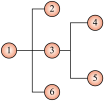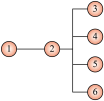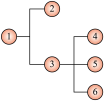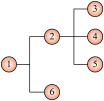There are 56 ethnic (民族的) groups in China. Different ethnic groups have their own special cultures. Let’s enjoy some of them.
The Bai people use a very old way, tie-dye (扎染), to dye clothes. Tie-dye has a history of nearly 1,500 years. During the Tang and Song dynasties, people chose tie-dyed clothes as gifts.
The Mongolian people live in the Mongolian yurts (蒙古包). These yurts are large round tents and their tops look like umbrellas. They are the traditional homes of the Mongolian people. The yurts are usually white because they’re made of sheep’s wool. And white is a symbol of happiness.
The Zhuang people like singing even more than talking. On the third day of the third Chinese lunar month, they hold a big singing festival. It is exciting and wonderful. All the people can’t help singing happily. Men and women singers sing in pairs. The winners are the “king”, and “queen” of singing.
The Miao people have a special festival, Manghao Festival. It’s in the first Chinese lunar month every year. The Miao people consider Manghao as a hero who helped to protect their homes. At the festival, young men dress up like Manghao and touch others to express good wishes.
1. When did people choose tie-dyed clothes as gifts?| A.During the Yuan and Song dynasties. | B.During the Tang and Ming dynasties. |
| C.During the Tang and Song dynasties. | D.During the Ming and Qing dynasties. |
| A.A big umbrella. | B.A traditional building. |
| C.A sheep’s home. | D.A symbol of happiness. |
| A.The Bai people. | B.The Miao people. |
| C.The Zhuang people. | D.The Mongolian people. |
| A.By choosing tie-dyed clothes as gifts. | B.By protecting their homes like a hero. |
| C.By sending some good wishes to others. | D.By dressing up and touching other people. |
| A.Special Cultures of Some Ethnic Groups. | B.Special Food of Some Ethnic Groups. |
| C.Special Festivals of Some Ethnic Groups. | D.Special Clothes of Some Ethnic Groups. |
相似题推荐
【推荐1】You are walking down the street in the middle of the day and you see someone wearing a green hat. Some people may think it’s fashionable while others don’t care at all. Do you wonder what wearing a green hat means in Chinese culture? Here are four colors and their meanings in Chinese culture.
GreenIn most cultures, green represents (代表) nature and is a calm color. However, in modern Chinese culture, green has a negative meaning. For example, when you say “His face looks green.”, it means he doesn’t look well. When you say someone is wearing a green hat, it mans the person’s partner is cheating on him or her.
YellowIn ancient China, yellow represented power. Only the emperor could wear this color. Yellow was also considered as a natural color. The Yellow River, the second longest river in China, got its name from he yellowish soil (土壤) in it. Now, when yellow is used in a sentence, it mans someone fails and that something doesn’t go as planed. For example, when you ask people how their relationship is going, they might say “huáng le”, which means they’ve broken up.
RedRed is considered as one of the luckiest colors in Chinese culture. In ancient China, the royal (皇室的) family wore bright red. In modern China, red is often seen at celebrations like weddings and festivals. Red also describes someone who is very popular, like a star. You will say “He is red.”
WhiteIn ancient China, white was considered as common people’s color. Back then, only the rich could afford to make colorful clothes. Common people couldn’t afford that, so most of their clothes were white. Now people still enjoy white clothes, but they sometimes connect white with bad things. It is connected with scary things like death.
1. What’s the purpose of the example in Paragraph 1?| A.To introduce the topic. | B.To make a comparison. |
| C.To express an opinion. | D.To show the result. |
| A.Wrong. | B.Deep. | C.Clear. | D.Bad. |
| A.White. | B.Red. | C.Green. | D.Yellow. |
| A.It is general and natural. | B.It is popular but harmful sometimes. |
| C.It is common but unlucky sometimes. | D.It is unusual and expensive. |
| A.Four colors in different cultures. |
| B.Four colors and their meanings in Chinese culture. |
| C.The development of four colors. |
| D.How to use colors in Chinese culture. |
| A. City Tour. Two teachers will teach you how to travel in a big city. You can plan the traffic line, and learn about the places of interest in this city. B. Suzhou Gardens. You can visit a few famous gardens in Suzhou. They are traditional Chinese buildings. We will show you around and tell you the art. C. Yue Culture. You can enjoy Cantonese Opera. Some teachers will tell you the history of it. You can also watch lion dancing. D. Chinese High-tech. The study is mostly in Tianjin High-tech Area. There are lots of different robots. You can visit a robot museum. E. Chinese History. We will take you to Xi’an. It is a big city with a long history. You can see old city walls and enjoy history shows. F. Tai Mountains. It’s a study on mountains, such as the plants, rocks, and so on. You can see beautiful plants from different mountains. |
【推荐3】For thousands of years, poetry has been the favorite type of literature in China.There were many famous poets from different periods of time in Chinese history, and thousands of their poems are still read and appreciated today.
To remind people of those classic Chinese poems and to promote cultural heritage(遗产), China Central Television (CCTV) has produced a TV show — Chinese Poetry Competition. The finale of the hit show’s second season was shown on February 7th.
Wu Yishu, 16, who studies at the High School Affiliated to Fudan University in Shanghai, came out on top. In an earlier episode(环节), Wu surprised the audience a lot when performing in a section entitled “Feihualing”. The games’ theme was “yue”. She recited lines from the Classic of Poetry, the earliest collection of poems in China.
As the old saying goes, “One who is filled with knowledge always behaves with elegance.” “The first time I saw her wearing traditional Han clothing on TV, I was impressed by her classical looks and good behaviors, ” said Huang Zijin, 16, a senior 2 students from Ningbo High School in Zhejiang province, “and I really admire her knowledge of poems.”
When it comes to teaching people about poetry, Li Dingguang, the show’s academic adviser, suggested that teachers should explain more about the beauty of the poetry and guide students to lose themselves in the poems’ lines.
1. The purpose of the Chinese Poetry Competition is to _______.| A.look for talented poets in the new period |
| B.honor famous poets from different periods of time in Chinese history |
| C.remind people of Chinese traditional culture and promote cultural heritage |
| D.read and appreciate all the great poems in Chinese history |
| A.braveness | B.beautiful looks | C.classic talents | D.Han clothing |
| A.If one learned a lot of knowledge, people will like him. |
| B.If one learned a lot of knowledge, he can behave properly. |
| C.If one wants to learn a lot of knowledge, he should work hard. |
| D.If one wants to learn a lot of knowledge, he should take part in activities. |
| A.Necessary. | B.Worrying. | C.Satisfying. | D.Boring. |
【推荐1】In Chinese celebrations, whether it is an important birthday or a traditional festival, one of the most typical elements (元素) is the lucky and auspicious (吉祥的) symbols.
To most Chinese, when it comes to lucky symbols, the top three are surely fu, lu and shou, which are sometimes called the three gods.
During Chinese New Year, we would put up red squares with the character fu on them. Some people would put their fu character upside down. In Chinese when we say the fu character is upside down, it sounds like good luck has arrived.
lu often has to do with one’s job and richness. Lu refers to well pay and ranks (等级) in ancient China. Hulu, gourds (葫芦), sounds like hulu (护禄) which means protecting lu. So traditionally, people use gourds to scare away bad spirits and illnesses and keep rich and successful.
Shou means long-lived life. Even nowadays when someone is having their holiday celebration, we would call this person shouxing, a god. At birthday parties for elder people, we often see peaches. That’s because according to the legend (传说), the Queen Mother of the West grows peaches in her own garden, and whoever gets to eat these peaches will live forever.
Besides the three, lucky and auspicious symbols can be easily found in the food we eat. For the Chinese New Year dinner, most families would have fish because the character fish sounds like surplus (有余). In southern China, niangao, a kind of rice cake is a lucky food because niangao sounds like getting higher every year. And for Lantern Festival, we have tangyuan, a kind of sticky rice dumplings. They are round shapes and the pronunciation of the food symbolizes being together.
1. The writer mainly tells us about __________.| A.typical Chinese traditional festivals | B.the secrets of richness and success |
| C.Chinese lucky and auspicious symbols | D.traditional Chinese eating culture |
A. | B. | C. | D. |
| A.wear a gourd with him or her | B.grow peaches in his or her garden |
| C.call the god, shouxing for help | D.have tangyuan with family often |
(Para. 1 =① Para.2 =② Para. 3 =③ Para. 4 =④ Para.5 =⑤ Para. 6 =⑥)
A. | B. | C. | D. |
【推荐2】If you go into the forest with friends, stay with them. If you don’t, you may get lost. If you get lost, these are what you should do.
Sit down and stay where you are. Don’t try to find your friends—let them find you. You can help them to find you. You can shout or whistle(口哨) three times. Stop. Then shout or whistle three times again. Any signal(信号) for three times is a call for help. When people hear you, they will know that you are asking for help.
If you don’t think that you can get help before night comes, try to make a little house with branches(树枝). Make a bed with leaves and grass by yourself.
When you need some water, you have to leave your little house to look for a river. Don’t just walk away. Get small branches and drop them when you walk to find the way back. If you have a pen and paper, leave notes(标记) along the way.
If you are careful and know what you are doing, you can also build a fire. Maybe someone will see the smoke(烟) and ask why there is a fire this time of the year, and they may come to find you.
The most important one is that you must be calm(镇定的) when you get lost in the forest and try to enjoy being lost for a while.
1. If you get lost, you can ________ and stay where you are.| A.sit down | B.shout all the time | C.look for friends | D.do nothing |
| A.Stay in one place and give signals if you get lost in the forest. |
| B.Make a house with branches if you think you’ll get help before night comes. |
| C.Build a fire so that your friends may find you by seeing its smoke. |
| D.The most important thing is to be calm when you get lost. |
| A.What to do when we get lost in the forest. | B.What to do when we need help. |
| C.How to travel in the forest. | D.Where to go on vacation. |
| A.① /②③④/ ⑤⑥ | B.① /②③④⑤/ ⑥ | C.①② /③④ / ⑤⑥ | D.①② /③④/ ⑤⑥ |
Knowing how to make such choices is a “life skill”, and we need these skills if we want to live useful and happy lives.
Some of these choices are small. For example, will I take an apple for lunch or a pear? Will I go to school by bus or on foot? Will I wear the red T-shirt or the blue one to the movies? Other choices are more important. For example, will I eat healthy food for lunch or will I eat junk food because it is nicer? Will I work hard in all my classes or will I only work hard in the classes I enjoy? We make choices like this every day.
We have to realize that the choices we make can affect(影响) the rest of our lives. Just as importantly, our choices can also affect other people. The next time you decide to waste time in class, play a joke on someone or talk loudly at the movies, think about this: Who else does your choice affect?
1. This passage mainly tells us that it’s important to _____________.
| A.make the right choices |
| B.know how to compare prices |
| C.know how to shop carefully |
| D.learn everything at school |
| A.know how to choose a part-time job |
| B.compare brands and prices |
| C.live useful and happy lives |
| D.learn things at school |
| A.Which fruit to take for lunch. |
| B.Which kind of food to eat, healthy food or junk food? |
| C.Which T-shirt to wear to the movies. |
| D.How to get to school. |
| A.nobody | B.the people around us |
| C.just ourselves | D.the prices of the things |



